Key takeaways:
- The Vintage Car Expo is a vibrant community gathering that celebrates automotive history and connects enthusiasts through shared stories and experiences.
- DIY projects enhance skills, provide a sense of accomplishment, and promote camaraderie among vintage car lovers.
- Choosing the right projects should consider personal skill level, availability of parts, and alignment with individual interests for a rewarding experience.
- Online resources, books, and video tutorials are invaluable for DIY enthusiasts seeking knowledge and support in vintage car restoration.
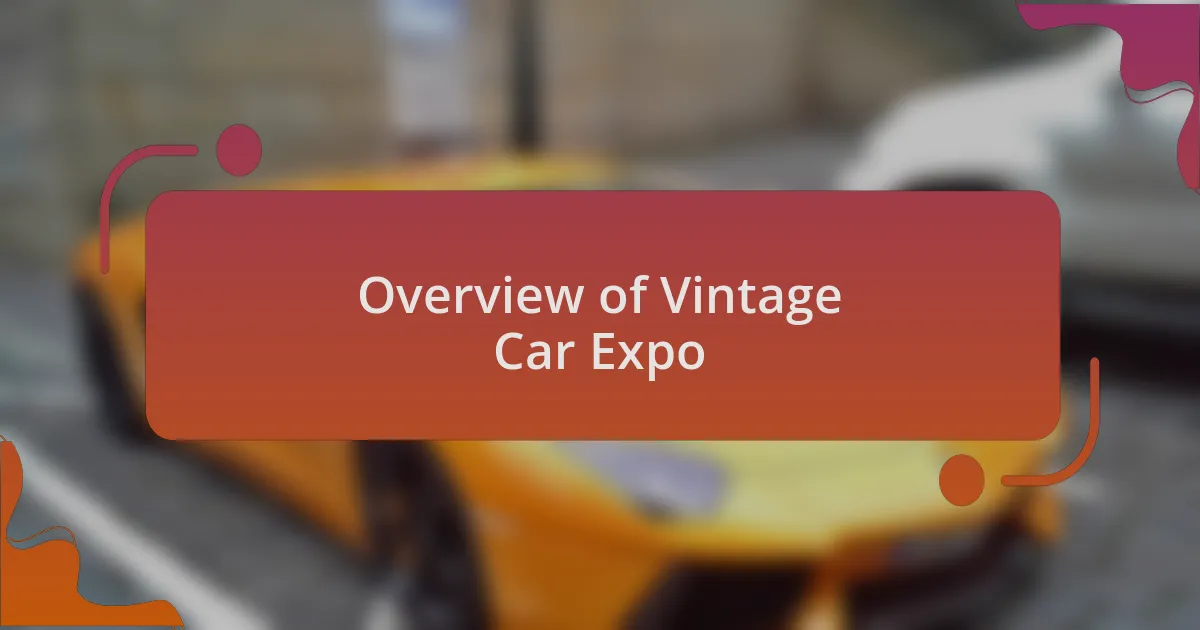
Overview of Vintage Car Expo
The Vintage Car Expo is a celebration of automotive history, where enthusiasts gather to showcase their prized vehicles. When I first attended, I was amazed by the sheer variety of classic cars on display, each with its own story to tell. Can you imagine the conversations sparked by a 1965 Mustang or a 1957 Chevy Bel Air?
Every corner of the Expo offers a treasure trove of memories and nostalgia. I vividly recall meeting a gentle soul who lovingly restored a 1949 Cadillac, sharing how each dent and scratch represented a moment in time. This personal touch is what truly brings the event to life; it’s more than just a show—it’s a community.
The atmosphere is electric, filled with the sounds of classic engines and the excited chatter of fellow car lovers. Have you ever felt that rush of admiration when you spot a rare vintage model? It’s that feeling that unites us, making the Vintage Car Expo an unforgettable experience for anyone who appreciates the beauty and craftsmanship of classic cars.
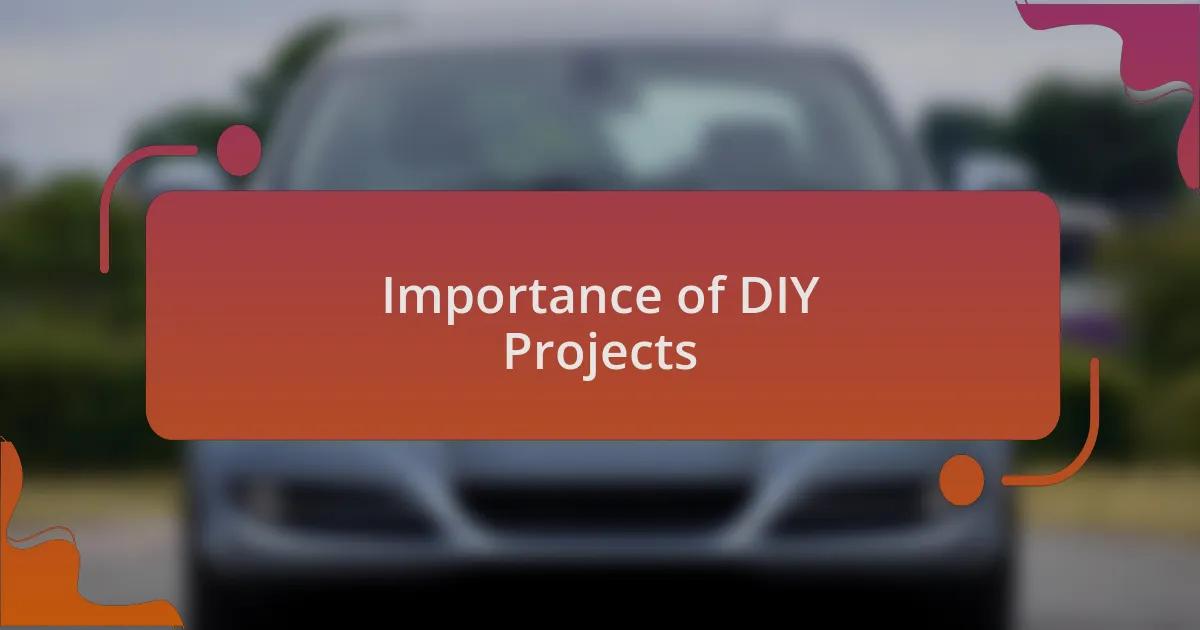
Importance of DIY Projects
Engaging in DIY projects is essential for car enthusiasts as it fosters a deeper connection with their vehicles. I recall when I decided to tackle the restoration of a vintage dashboard myself. The satisfaction that washed over me upon completing it wasn’t just about the craftsmanship; it was about the memories embedded in every screw and bolt.
Furthermore, taking on these projects cultivates valuable skills and boosts confidence. I remember struggling to replace my car’s worn-out upholstery; it was challenging, but the moment I saw my hard work pay off, I felt an overwhelming pride. Isn’t it incredible how tackling these hands-on tasks not only revives our cars but also revives our sense of capabilities?
Lastly, DIY projects bring a sense of community among vintage car lovers. Sharing tips and advice with fellow enthusiasts can transform a solitary effort into a collaborative adventure. I often find myself in discussions at the garage, exchanging stories and learning from others’ experiences. Have you ever had a moment where a simple project led to lasting friendships? It’s those connections that enhance our passion for vintage cars.
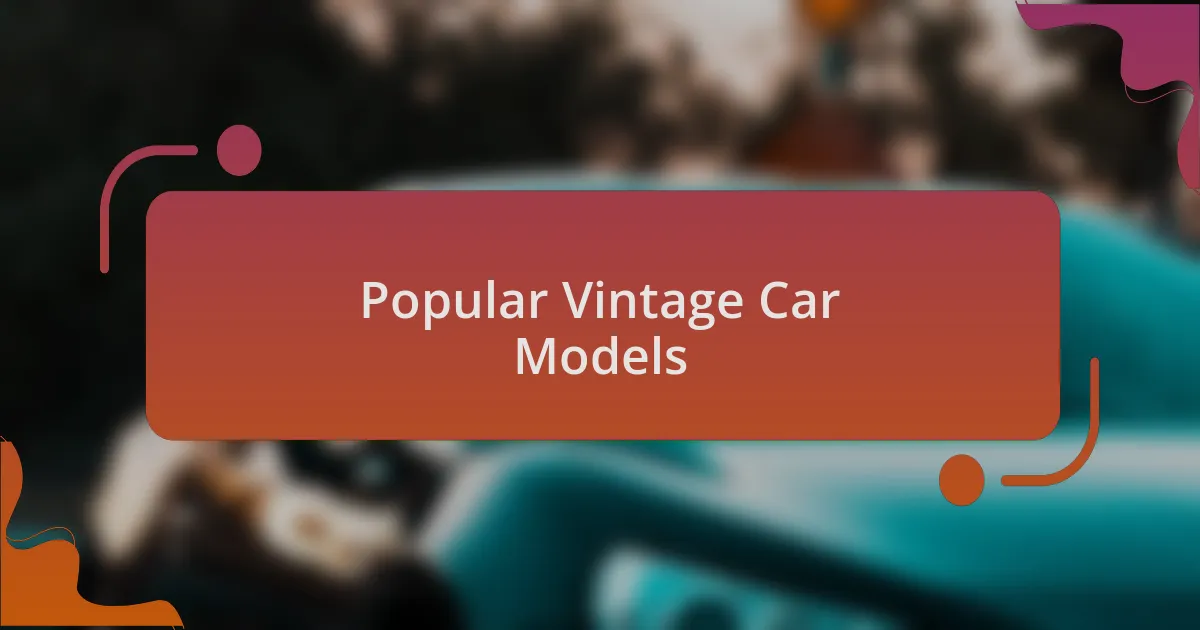
Popular Vintage Car Models
The world of vintage cars is filled with iconic models that spark nostalgia and admiration among enthusiasts. Take the Ford Mustang, for instance; its timeless design and powerful performance make it a favorite among collectors. I remember attending a vintage car show where a beautifully restored Mustang drew a crowd. It reminded me just how captivating these classic lines can be.
Then there’s the Chevrolet Corvette, a powerhouse of American automotive history. That sleek silhouette and the roar of its engine always give me chills. I once had the chance to ride in a 1967 Corvette; the experience was exhilarating! The feeling of gliding along the road in such a remarkable vehicle was unforgettable. Have you ever experienced that rush of excitement driving a piece of history?
Finally, we can’t forget about the Volkswagen Beetle, which holds a special place in the hearts of many. It’s not just a car; it’s a symbol of an era. I used to have a friend who owned one, and the joy we had cruising with the top down was unparalleled. It’s fascinating how a vintage car can encapsulate memories and emotions, don’t you think? Each model has its own story and charm, creating a tapestry of history that we all cherish.
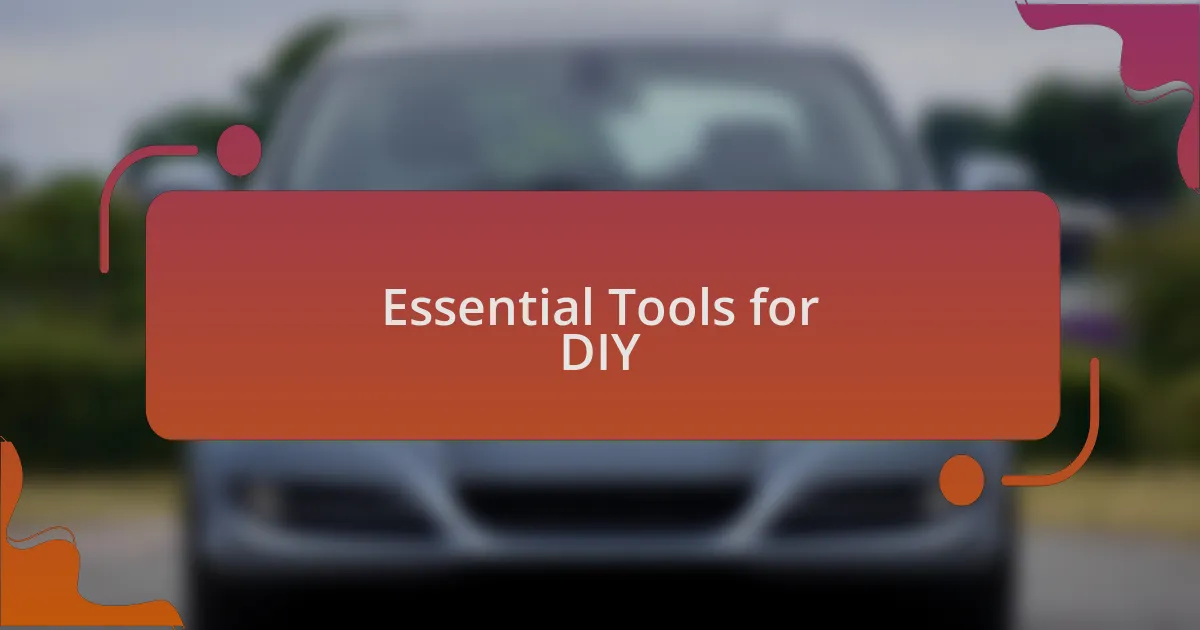
Essential Tools for DIY
When embarking on DIY projects for vintage cars, having the right tools is essential. I remember the first time I tried to restore an old engine without a proper set of socket wrenches. It turned into a frustrating experience, and I quickly realized that investing in quality tools saves both time and sanity. Have you ever felt that rush of satisfaction when the right tool effortlessly fits the job?
A basic toolkit should include essentials like screwdrivers, wrenches, and pliers, but I’ve found that a torque wrench is invaluable for ensuring everything is assembled correctly. During my last restoration project, I overlooked this tool and ended up with a few bolts that were too loose. It taught me the importance of attention to detail and proper torque, especially when dealing with classic cars that demand precision. Do you know how much a small mistake can snowball into a larger problem later on?
Additionally, don’t underestimate the power of a good multimeter. I once struggled with an electrical issue in my vintage car and ended up guessing where the problem lay. Once I finally picked up a multimeter, it made diagnosing the issue so much easier. It’s like having a diagnostic friend who can help you troubleshoot! What’s your go-to tool for solving automotive mysteries?
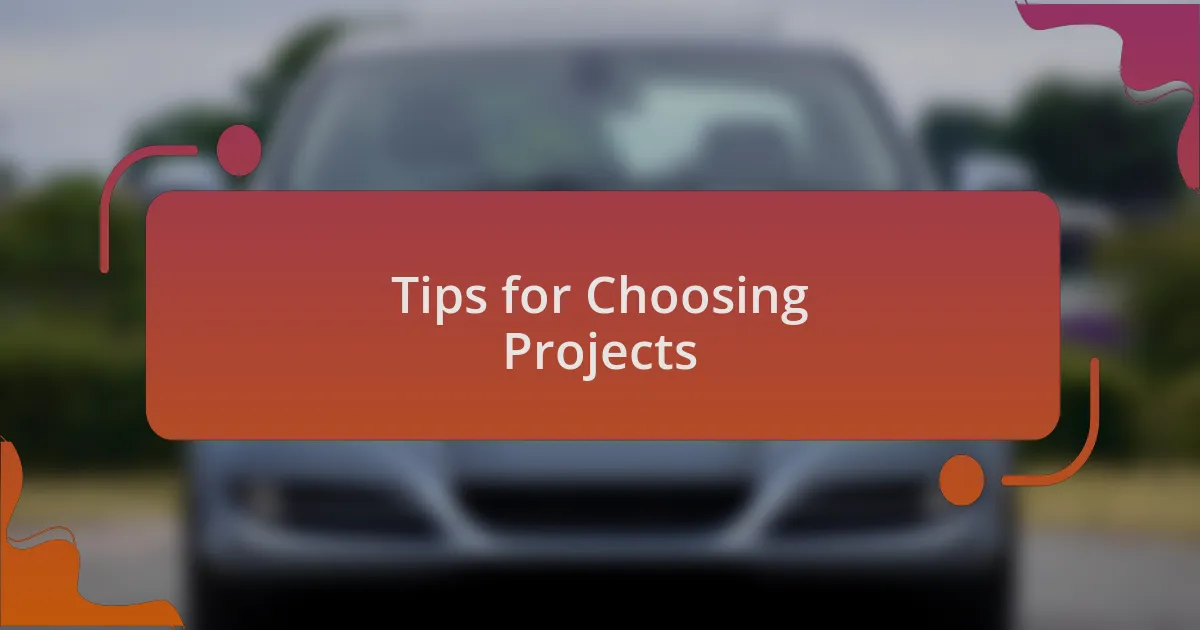
Tips for Choosing Projects
When selecting DIY projects for vintage cars, it’s crucial to consider your skill level and comfort zone. I remember diving into a complete frame-off restoration early in my journey, which nearly overwhelmed me. Reflecting on that now, I suggest starting with more manageable tasks like painting or minor repairs to build confidence before taking on larger challenges. What project would you feel most excited to tackle?
Another factor to keep in mind is the availability of parts. I learned this the hard way when I committed to restoring a specific make and model, only to discover that sourcing components was nearly impossible. Narrowing your focus to models with a robust aftermarket support can save you a lot of headache and disappointment. Have you ever been in a situation where finding a part felt like searching for a needle in a haystack?
Lastly, don’t forget to align your projects with your interests and passions. For instance, I’ve found joy in customizing cars, exploring unique paint schemes, and modern upgrades. Choosing projects that resonate with you will not only enhance your experience but also ensure that the time and effort invested feel truly rewarding. What drives your passion for vintage cars?

My Favorite Classic Car Projects
There’s something about restoring a classic car that just pulls at my heartstrings. One of my favorite projects was reviving a 1967 Mustang that had been left to rust in a barn for decades. The moment I turned the key after countless hours of work, and it roared back to life, was a rush like no other. Have you ever experienced that thrill of breathing new life into an old vehicle?
Another project that stands out for me involved reupholstering the interior of a 1950s Chevy Bel Air. I vividly remember the satisfaction of picking out the fabric—it felt like personalizing a piece of history. The transformation was not just aesthetic; it added an emotional layer to the car, making it feel like a part of my own story. How does the idea of modifying a car’s interior resonate with your personal style?
Finally, I can’t forget the time I tackled a DIY engine swap in a 1970 Dodge Charger. It was intense, and I’ll admit there were a few moments where I doubted my abilities. Yet, each problem solved and every small victory felt like a stepping stone to mastering my craft. What challenge do you find most exhilarating when working on a classic car?
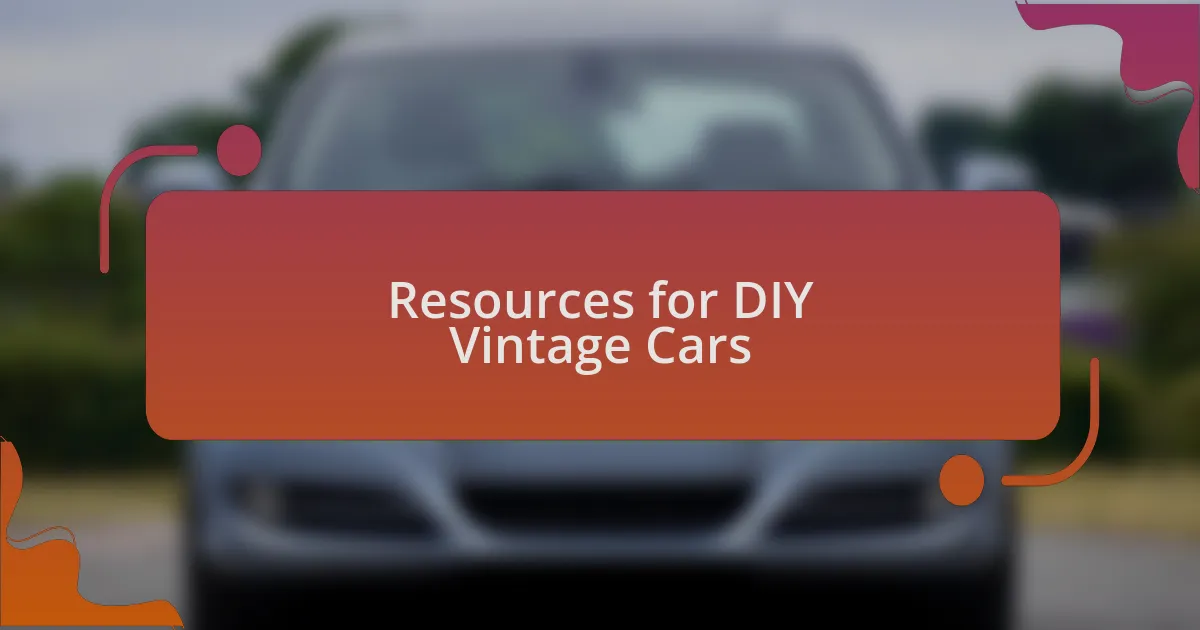
Resources for DIY Vintage Cars
When it comes to resources for DIY vintage cars, there’s a wealth of knowledge out there. I’ve often turned to online forums and communities like Classic Car Restoration Club, where fellow enthusiasts share invaluable advice and experiences. Have you ever found a solution there that saved you hours of frustration? I know I have!
Books can also be a treasure trove for the DIYer. I still remember poring over a well-worn manual about vintage Fords. The diagrams and detailed explanations transformed complicated tasks into manageable projects. Isn’t it a wonderful feeling when you can visualize the steps you need to take?
Additionally, YouTube has become an indispensable resource for DIY enthusiasts. I can’t count the times I’ve watched tutorials that guided me through tricky fixes, like rewiring an entire dashboard. Each video felt like having a mentor right in my garage. Isn’t it incredible how technology connects us with so much knowledge?